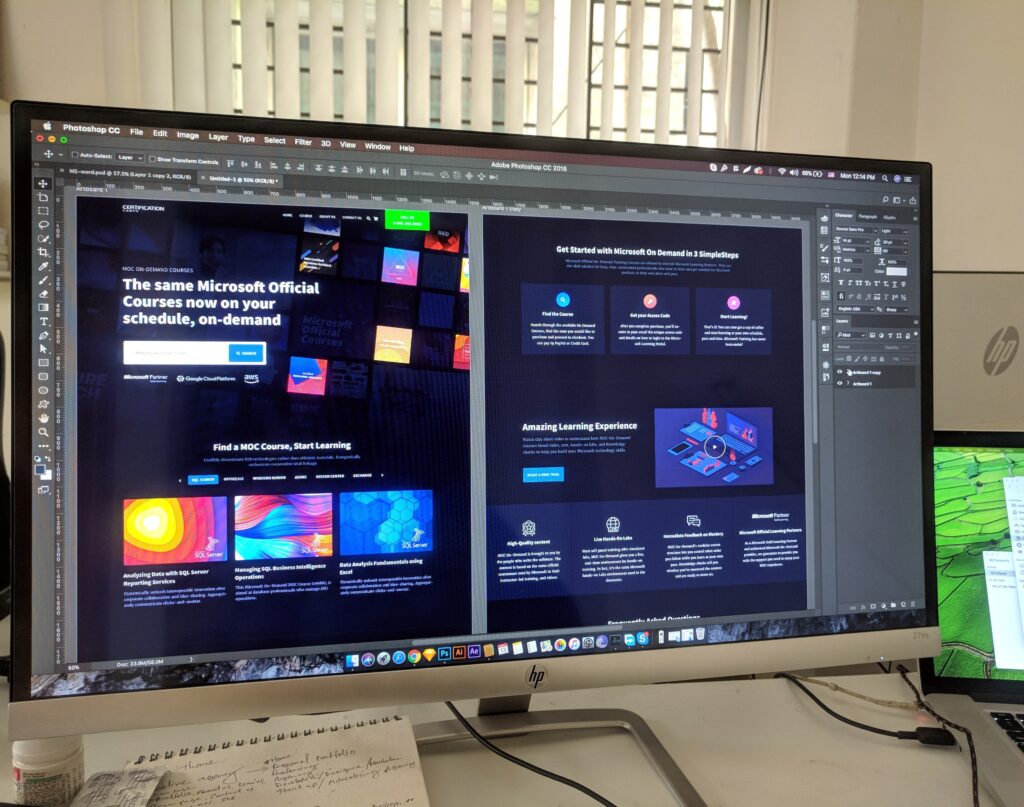
Don’t stress about becoming a web designer – it’s totally doable! If you’re curious about the basics, we’ve whipped up this guide that dishes out all the essential know-how to kick off your web design journey.
Web Design and Web Designer: The Fundamentals
What is web design?
Web design refers to the process of creating the visual appearance and layout of websites. It involves various elements, including the overall look and feel, the arrangement of content, the use of colors, typography, images, and graphics, as well as the user interface (UI) and user experience (UX) design. The goal of web design is to create a visually appealing and user-friendly website that effectively communicates the intended message and engages visitors.
What are the responsibilities of a web designer?
The responsibilities of a web designer can vary depending on the specific role, company, and project, but here are some common responsibilities associated with the role of a web designer:
- Visual design: Creating the overall visual style and layout of websites, web applications, or other digital interfaces. Web designers select and design color schemes, typography, and graphical elements to create a cohesive and visually appealing design.
- User Interface (UI) Design: Designing the user interface elements, such as buttons, menus, forms, and navigation components and ensuring that the UI elements are intuitive, user-friendly, and aligned with best practices for usability.
- User Experience (UX) Design: Designing the overall user experience to ensure that the website or application is easy to use, engaging, and meets the needs of the target audience based on customer behavior research.
- Responsive Design: Designing websites that work seamlessly across different devices and screen sizes, ensuring a consistent and optimal user experience.
- Testing and Iteration: Conduct usability testing and gathering feedback to identify areas for improvement in the design.

6 Essential Skills for A Web Designer
Nailing website design is like mixing the perfect smoothie – you need a scoop of techie genius and a splash of creative mojo. So, what’s in the recipe for success? Here are the top six must-have skills:
- Coding Basics: Think of HTML and CSS as your design superpowers. Knowing them helps you talk with developers and bring your ideas to life.
- Graphic Design: Proficiency in creating visually appealing graphics, typography, colour schemes, and other design elements that contribute to the overall look of a website. Designers should be familiar with design tools like Adobe Photoshop, Illustrator, XD, Sketch, or Figma for creating and refining designs.
- Wireframing and Prototyping: Ability to create wireframes and interactive prototypes to visualize and test design concepts.
- Digital Marketing: Business websites primarily focus on generating sales. Therefore, they often seek web designers who possess a foundational understanding of additional digital marketing proficiencies such as UX, UI, search engine optimization, content writing, and advertising. This knowledge serves as a potent instrument, enabling web designers to grasp insights into the behaviors of website visitors.
- Responsive Design: Proficiency in designing websites that adapt and function well across various devices and screen sizes.
- Collaboration: Effective communication and teamwork skills to collaborate with developers, content creators, and other stakeholders.
Why Beginners Find Web Design Is Hard?
For newbies in web design, the challenges might be a bit overwhelming. Grasping complex coding languages like HTML and CSS might feel like learning a new dance move. Balancing visual aesthetics with optimal user experience can be a bit like juggling water balloons. And making your website work smoothly on all sorts of gadgets? That’s like taming a bunch of wild tech beasts! You’ll also dive into the magical world of typography, color theory, and layout principles – it’s like putting together a puzzle. Staying updated with the latest design trends, collaborating with your team and adapting with the design process? It will take time.
But, don’t sweat it! With strong determination and learning, you’ll totally crush these challenges and rock the web design scene.

Steps to Get Started in Web Design
Embarking on your web design journey is like setting off on a grand adventure through the digital landscape. But don’t worry, I’ve got your treasure map right here – a step-by-step guide to help you navigate the exciting world of web design:
- Foundational Familiarity: Think of HTML and CSS as your trusty companions on this journey. Dive into their secrets with the help of friendly mentors like W3Schools and Codecademy.
- Cultivating Creativity: Unleash your inner artist by exploring graphic design tools like Adobe XD, Figma, and Canva. Get ready to paint your digital canvas with colors and shapes!
- Blueprints of Imagination: Imagine you’re crafting an architectural masterpiece – but on the web. Sketch wireframes on paper or digitally to map out your design ideas.
- Mastery of Languages: Delve into coding languages like JavaScript to make your designs dance and sing. Gather knowledge from the wisdom-filled scrolls of FreeCodeCamp and MDN Web Docs.
- Embracing Errors: Every wizard falters sometimes. Embrace your coding mishaps, experiment, and breathe life into existing projects on platforms like CodePen or GitHub.
- Apply the Knowledge: It’s your time to shine! Embark on personal projects – create a portfolio, fashion a blog, or spin your digital tales. Your imagination is your limit!

Conclusion
In wrapping up our journey through the realm of web design, remember that every great designer was once a beginner. Embrace the challenges, cultivate your creativity, and let your curiosity be your compass. With the knowledge you’ve gained, venture forth into the digital canvas, ready to craft captivating websites that leave your unique mark on the ever-evolving online landscape. Is web design hard anymore? Your design odyssey has just begun!
Don’t forget to visit our blog for useful information about the world of website design and development.



